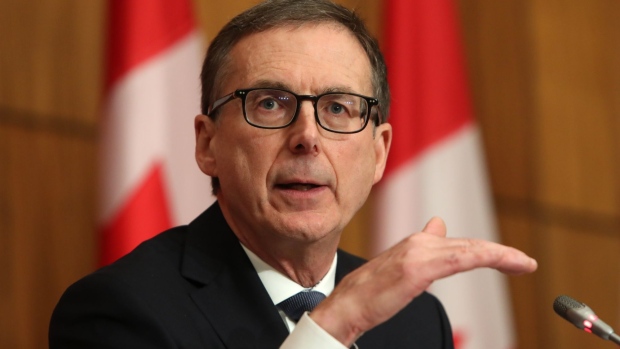Oct 14, 2022
Bank of Canada’s Macklem on Future Rate Hikes, Inflation: Voices
, Bloomberg News

(Bloomberg) -- Here are selected comments from Bank of Canada Governor Tiff Macklem’s press roundtable on Friday in Washington, where he was attending meetings of the International Monetary Fund.
On future rate hikes:
“The key things we’re looking at are how quickly or how slowly global supply chain global issues are resolved, and how quickly those global inflationary pressures start to ease off. We have seen some easing of global supply pressures, but certainly this week’s meetings had only reinforced just how much uncertainty there is.”
“The second thing we’re looking at is the balance between demand and supply in the Canadian economy. The economy is clearly overheated. You can see this is very evident in labor markets where we’ve got very high vacancies. Businesses are certainly telling us that they’re having trouble finding enough workers to meet the demands of all the clients.”
“We have raised rates. It’s certainly starting to have some effects in the more sensitive parts of the economy, particularly housing. But it’s gonna take some time for monetary policy to work through the economy and that’s something we’re gonna be watching very closely.”
“Most importantly we’re watching the evolution of inflation itself and what’s happening with inflation expectations. We’ve seen the last couple of months total CPI inflation has come down about a percentage point. But measures of core inflation, measures of underlying inflation, are becoming increasingly relevant. We have yet to see a clear turning point in underlying inflation. Inflation continues to broaden across goods and services. So that’s something we will be looking at very closely”
“And then finally, inflation expectations. Shorter run inflation expectations have risen with inflation and the longer inflation stays high, the greater is the risk that those higher short-run inflation expectations bleed into longer-run inflation expectations. So far longer-run (inflation expectations) appear to be reasonably anchored around the 2% target. But we certainly are seeing more dispersion among survey respondents with more people thinking that inflation could stay higher for longer”
“Certainly one thing we will be looking for is evidence that the rapid increase in interest rates that we’ve done so far and any further moves we need to do are reaffirming inflation expectations around our 2% target.”
On strong USD:
“We’re certainly going to be watching closely how the US economy evolves, how inflation in the US evolves and what the Fed does with their rates. And we’ll be factoring that in as we take decisions in Canada.”
“If you look over the last couple years, if you look over the last year as the US dollar began to strengthen through most of that period, the Canadian dollar actually pretty much kept pace with the US dollar. So we’ve actually appreciated against most other currencies. In the last six weeks, two months or so, we’ve seen a further leg up in the US dollar.”
“The US exchange rate is the one that matters the most for us. The majority of our trade is with the US. So we’ll see how long that lasts, we’ll see what the persistence is. But certainly, if it persists, it does mean that imports from the US and Canadian vacations in the US will be more expensive. So that will mean that, other things equal, we’re gonna have more work to do on interest rates.”
On economic growth:
“The growth needs to slow. We need growth below potential, below trend for a period so that supply can catch up and we can take the steam out of inflation. Saying growth needs to slow doesn’t imply that we need a big period of negative growth. We’ll certainly need considerably lower growth.”
“We are seeing that growth is coming down and we’re working on updating our projections and we’ll see where we land. But I think you can expect to see pretty modest growth, but that’s still growth. That’s not a recession.”
“An important reason why we have front loaded our response is that in our view, that is the best chance to get this soft landing. If we can keep inflation expectations well anchored, if we can get inflation moving down, we can avoid the need for even bigger increases and an even sharper slowing of the economy.”
On global tightening:
“What I took away from the discussions was central banks have been raising interest rates quickly, much bigger than normal steps and with that there has been a marked tightening in global financial conditions. By and large, that has been reasonably orderly. That tightening is intended, it is needed to control inflation.”
“But there is also awareness though that the speed of the tightening, the extent of the tightening could have some unintended consequences. And we have seen some places where the use of leverage has created some very swift and disruptive liquidity issues. There have been very rapid changes in certain markets.”
On neutral rates:
“We think a long-run neutral rate when inflation expectations are well anchored on the target is between 2% and 3%. So we’re now just above that and we’ve signaled that we think further interest rate increases are warranted. So I think you can expect that we’re gonna go further above. How much further above and for how long is really going to depend on how the economy and importantly how inflation evolves.”
©2022 Bloomberg L.P.






